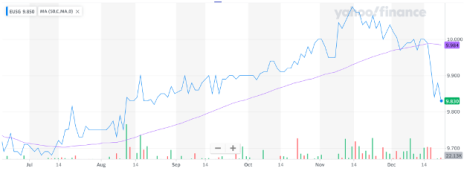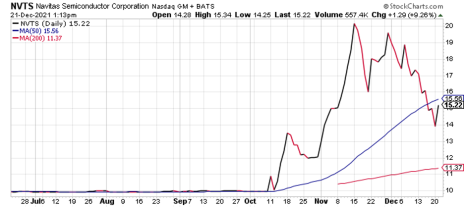Just this year electric vehicle (EV) sales reached a double-digit share of auto sales, which is almost certain to grow given the hundreds of billions of dollars that legacy automakers have committed to EV development over the next decade.
Companies like Tesla (TSLA), Rivian (RIVN), and Lucid (LCID) have attracted a lot of ink for their sky-high valuations, which can certainly cause hesitation in some investors. Alternatively, the traditional automakers typically trade at more reasonable valuations, but don’t represent as pure an investment in EV development.
Fortunately, the development of EVs is creating an entire ecosystem of companies that are poised to grow with the industry, and these three are high on my watchlist.
European Sustainable Growth Acquisition (EUSG)
EUSG is a special purpose acquisition company merging with ADS-Tec Energy, a German manufacturer of chargers that can refuel an EV faster than any charger on the market, even Tesla’s Supercharger. ADS-Tec’s ChargeBox takes about five minutes to provide 100 miles of range – the same time it takes to fill a conventional car with gasoline.
ADS-Tec Energy’s system can do that because it sends much more electricity out, as high as 320 kilowatt hours (kWh). No car yet can accept that much power – the highest charging model we know of is the Taycan from Porsche, which can accept 270 kWh. The Tesla Model 3 Performance can draw up to 250 kWh, while the Ford (F) Mach-E 3 and Audi E-Tron take 150 kWh. Demand for ‘ultra-fast’ chargers, meaning 150kWh or greater, already was 70% of the market in 2020. It’s easy to see that as consumers realize their EVs’ ability to accept more powerful charges also plays a part in faster refueling, they’ll demand better charging performance from their cars and their chargers.
ADS-Tec Energy has some 50 patents around its super-fast charging system, but I’ll point out one big differentiator. ChargeBox uses a refrigerator-sized battery that stores up energy and sends out the peak charge for EVs from it. That means it can be installed anywhere a standard electrical wire can reach the battery. Other high-powered EV chargers need upgrades across the electrical grid to feed in the power they need. That’s a much bigger investment for municipalities and landlords. ADS-Tec has made inroads in Europe and with Porsche, which deploys ADS’ mobile, truck-sized ChargeTrailer to its owner events, to refuel many EVs at a time. ChargeBoxes are where growth will really come from in the near-term and ADS-Tec Energy just started focusing on selling them in the U.S., recently inking a deal to sell 200 to Miami-Dade County.
My subscribers are up 50% on the stock in just five weeks, and it remains a buy: I calculate the business is valued, with a fully diluted share count assuming exercise of SPAC warrants, at about 8 times next year’s sales. Management says it can sell $85 million of product in 2022, up from $44 million this year. That’s far cheaper than other EV charging stocks. Because EUSG is a SPAC that has yet to close the merger, there are some risks, including the often extreme volatility SPACs see around merger closings. But, big picture, I like it.
The chart above is courtesy of finance.yahoo.com.
EV Ecosystem Stock #2: Navitas Semiconductor (NVTS)
A crucial part of the EV ecosystem, as in so many industries, are computer chips. Notice I didn’t say ‘silicon’ chips. That’s because silicon has hit a wall, of sorts: Its theoretical speed and capacity are maxed out. Navitas makes integrated circuits out of gallium nitride (GaN), a material that replaces silicon because it has the ability to handle greater voltage, higher heat and perform faster in a smaller form factor. For that reason, there’s a market for EVs to use GaN-based chips from Navitas, for inverters, the items that regulate electrical current, as well as elsewhere in battery mechanics and EVs’ traction drive systems. Because GaN circuits are smaller and faster, they can allow EVs to charge three times faster than comparable silicon offerings, while saving enough energy to extend EV mileage by about 5%. (GaN circuits are also used in electronics, data centers and photovoltaic systems).
The market for GaN chips is small right now and Navitas will generate about $27 million in sales this year from Lenovo, Amazon and LG, among other customers, most of which is for phone and laptop chargers using GaN circuits. The semiconductor company has a deal with an undisclosed EV supplier for on-board chargers that could be worth $400 million by 2030, if all goes well. Third-party estimates are that the total GaN market will hit $2.1 billion in 2025, up from just $20 million last year and keep rising from there. Shares have rallied lately after the president of China’s Xiaomi, a large manufacturer of mobile phones, appliances and, soon, EVs, said Xiaomi and California-based Navitas have “perfect” business alignment. My subscribers recently booked 150% profit in five months on most of our position, but I’m holding a partial position to gain more upside.
Li-Cycle Holdings (LICY)
It’s no secret the least environmentally friendly part of EVs is the battery: lithium and other metals are often mined in less-than-ideal conditions. To improve the industry’s eco-footprint, recycling will be essential – and is becoming mandated in many jurisdictions.
Li-Cycle recycles lithium, as well as cobalt and nickel, using a non-combustion ‘wet chemistry’ method that is environmentally friendly and cheaper than mining. Right now, the five-year-old company recycles primarily computer and power-tool lithium-ion batteries at its New York and Ontario facilities. But the business is built around EV batteries. In the near-term, Li-Cycle will be recycling battery-maker trim material, which is the lithium discarded during the manufacturing process. That can be significant: Conservatively 10% (and as much as 30%) of lithium is wasted by battery makers in original manufacturing. That’s equal to 4.5 gigawatts (GW) of capacity of all U.S.-made batteries this year. Based on planned U.S. battery factory capacity, by 2025 the equivalent of 29 GW of battery lithium will be discarded! In the long run – 10 years out and beyond – all those EVs being sold today will need their batteries recycled too. Li-Cycle is opening new facilities in Arizona, Alabama and expanding its Rochester, N.Y. plant, to vastly increase recycling capacity, more than to 25,000 tons per year by 2023.
It has bigger plans too. Li-Cycle recently took a $100 million investment from Koch Industries to help fund expansion in North America and the rest of the world, with an aim to 240,000 tons a year global capacity. In addition to money, Koch will also provide the ability to manufacture Li-Cycle’s “spoke” recycling facilities in Texas and Poland and ship to their final destination. Shares have rallied in recent weeks as word of Li-Cycle’s business gets out– it went public by SPAC earlier this year. My subscribers are up 50% on our investment right now. Still, Li-Cycle remains a growth story: its $1.9 billion market cap dwarfs the few million Li-Cycle will make this year, but with $900 million in contracted buyer off-take through 2025, there is a lot of business to come.
Do you have a favorite stock for playing the EV Ecosystem stock boom? Let us know in the comments below.


